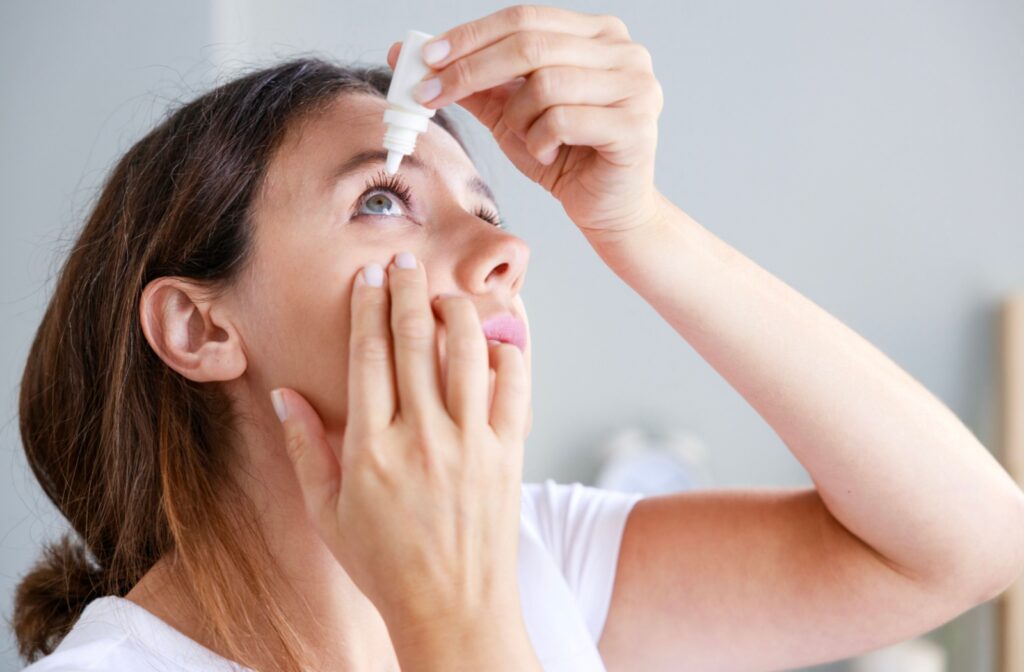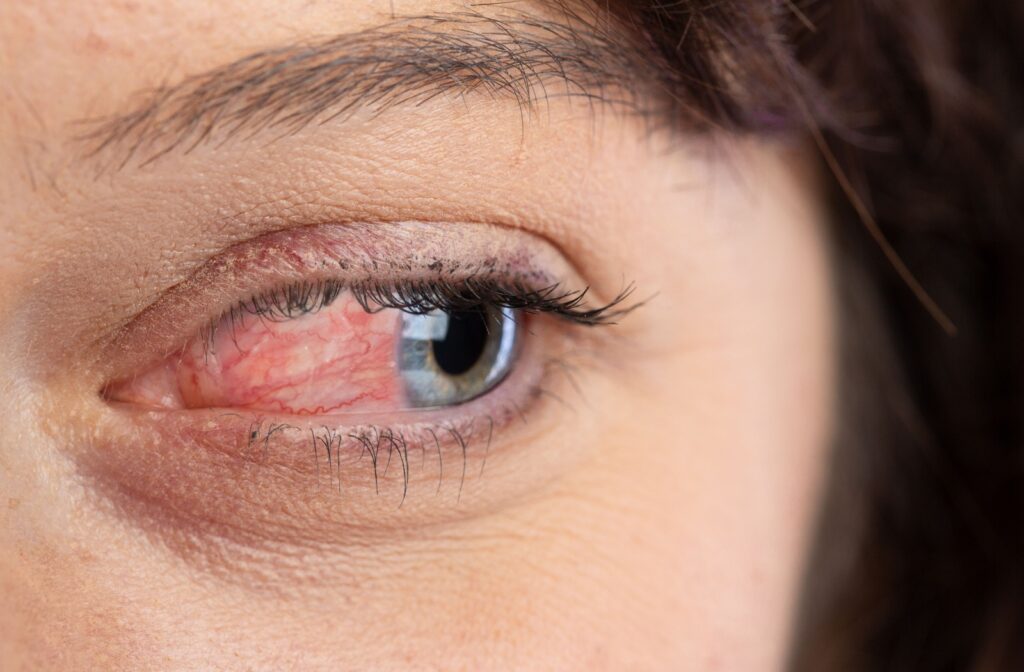Eye health can sometimes feel like a mystery. You might have redness, itching, or discomfort around your eyes and wonder what’s causing it. Two common culprits are ocular rosacea and blepharitis. While they share some overlapping symptoms, ocular rosacea and blepharitis are distinct when it comes to their causes, symptoms, and treatments. Understanding these differences can make a big impact on your eye comfort and overall healthcare.
At ProOptix Eye Care, we see plenty of patients wrestling with these issues, and we’re here to help. Our modern, family-friendly approach is built on a foundation of knowledge, kindness, and trust—which means you’ll always feel like family when you come through our doors.
If you’re experiencing eye discomfort or just want to stay proactive about your eye health, book an eye exam with us today!
What is Ocular Rosacea?
Ocular rosacea is linked to a skin condition called rosacea, which often causes redness and inflammation on the face. About 13 million Americans live with rosacea, and many don’t realize that it can also affect the eyes. Ocular rosacea targets the delicate tissues around the eyes and eyelids, leading to symptoms that can range from mild to severe.
Symptoms of Ocular Rosacea
Common signs of ocular rosacea include:
- Persistent redness, especially around the eyelids
- Dry, gritty sensations in the eyes
- Watery or itchy eyes
- Increased sensitivity to light
- Swollen or irritated eyelids
- Feeling like there’s something stuck in the eye
Because these symptoms are linked to the same triggers as facial rosacea—spicy foods, alcohol, heat, or stress—they can sometimes flare up unpredictably.
What Causes Ocular Rosacea?
The exact cause of ocular rosacea isn’t fully understood. However, it’s often linked to underlying inflammation in the body. People with rosacea on their skin are more likely to develop ocular symptoms, but it’s not guaranteed.
At ProOptix Eye Care, we take ocular rosacea seriously because, if left untreated, it can lead to complications like corneal damage or vision changes.
What is Blepharitis?
Blepharitis, on the other hand, is a condition specifically tied to the eyelids. It happens when the oil glands along the base of the eyelashes become clogged or inflamed. This leads to irritation that primarily affects the edge of the eyelids. Unlike ocular rosacea, blepharitis isn’t linked to facial rosacea but rather to issues like bacteria, allergies, or skin conditions like seborrheic dermatitis.
Symptoms of Blepharitis
Blepharitis symptoms can be similar to ocular rosacea, but there are a few telltale signs:
- Crusty buildup around the base of the eyelashes (especially in the morning)
- Red, itchy, or swollen eyelids
- Flakes or dandruff-like skin falling from the eyelids
- Burning or stinging sensation in the eyes
- Eyelash loss or misdirected growth
- Excessive tearing or dry eye
Blepharitis is typically a chronic condition, meaning it sticks around or comes back often. At ProOptix Eye Care, we see many families dealing with recurring cases of blepharitis, and we’re ready to help find solutions tailored to your needs.
What Causes Blepharitis?
Blepharitis is usually caused by an overgrowth of bacteria on the eyelids or by conditions like meibomian gland dysfunction (a problem with the oil glands that keep your eyes moist). Poor eyelid hygiene can also contribute.
Just like ocular rosacea, untreated blepharitis can lead to eye infections or complications like styes or chalazion (small, painful lumps on the eyelids).
How Are They Different?
Though they might seem similar at first glance, here are the main differences between ocular rosacea and blepharitis:
- Causes: Ocular rosacea is tied to facial rosacea and systemic inflammation, while blepharitis is more often related to bacteria, allergies, or oily gland blockages.
- Location: Ocular rosacea affects both the eyelids and the eyes themselves, while blepharitis is focused on the eyelids.
- Appearance: Crusty residue or flaking skin is a hallmark of blepharitis, but not of ocular rosacea.
- Triggers: Ocular rosacea is triggered by lifestyle factors like diet, temperature, or stress, while blepharitis is more connected to hygiene and gland health.
Sorting out these differences is vital to ensuring the right care.
Treatment Approaches
A personalized approach to treatment is best. This means listening, assessing, and recommending solutions that work for your specific condition.

Treating Ocular Rosacea
The goal here is to reduce inflammation and prevent flare-ups. Treatment options may include:
- Prescription eye drops or ointments to calm inflammation
- Oral antibiotics for more severe cases
- Warm compresses to relieve symptoms and open blocked glands
- Identifying and avoiding triggers like alcohol, spicy foods, or extreme heat
We also focus on patient education. Knowing what triggers your symptoms can make managing ocular rosacea easier day-to-day.
Treating Blepharitis
Blepharitis management often revolves around good eyelid hygiene. Here’s what we typically recommend:
- Daily cleansing of the eyelids with warm water or eyelid scrubs
- Using warm compresses to unclog oil glands
- Antibiotic or medicated eye drops to fight bacterial overgrowth
- Treating underlying conditions, like dry eye or seborrheic dermatitis
We also offer in-office treatments—such as thermal lid therapies—that provide a more advanced, long-lasting solution for moderate to severe cases.
When to See an Eye Doctor
If you’ve been struggling with redness, irritation, or discomfort around your eyes, it’s time to get checked out. Even if the symptoms seem minor, conditions like ocular rosacea and blepharitis can lead to more serious issues without proper treatment.
At ProOptix Eye Care, we pride ourselves on offering a mix of routine eye care and medical services like dry eye treatment, ensuring our patients have access to comprehensive care. Whether you’re a long-time patient or it’s your first visit, we’ll make sure you feel comfortable and informed every step of the way.
Clearer Eyes, Healthier Vision
Understanding the differences between ocular rosacea and blepharitis is key to getting the right treatment and relief. Both of these conditions can be frustrating, but with a trusted partner like ProOptix Eye Care, you don’t have to manage them alone. Our family-run practice is committed to guiding you through your eye health journey with professionalism and warmth.
If you’re ready to take control of your eye health, call us or book an appointment online today. We can’t wait to help you see and feel your best!





